I first headed to Claire Oliver Gallery because of a video Claire had posted of gallery artist Laetitia Soulier creating a piece of her Fractal Architectures series. It is a timed lapse video showing Laetitia making an architectural model for her photographs. If you know my work you know that I am a pushover for anything architectural. The models are finely crafted dollhouse like structures with fractal-designed motifs. I was struck by the superb craftsmanship and attention to detail given to each of the parts in the model. Soulier then incorporates photographs of children into photographs of the architectural models. The children appear Gulliverian in her Lilliputian interior spaces. The photographs are as eye-catching as they are intriguing, layering a striking visuality with a sense of psychological tension and mystery.
One of Soulier’s photographs The Square Roots 2 hangs in the stairwell of the gallery. It shows an interior space of a two-storied dwelling that is covered in a green fractal pattern. The structure is opened towards the viewer like a dollhouse. The viewer can even observe the floor joists between the floor of the second story and the ceiling of the first floor. A tree is growing in the second story space its roots lifting up the floorboards and penetrating down to the first floor. A boy of Gulliverian scale is resting his head on the floor of the second story with his feet warmly nestled on the first floor. A red wheelbarrow rests at the roots of the tree. The boy looks peaceful and is not disturbed by his overgrown size and his cramped dwelling. The organized design of the rooms and the green fractal pattern give this photograph a sense of calm to an otherwise uncomfortable situation. Unlike Alice’s Adventures the boy seems at ease with his outsized proportions.
Soulier’s The Matryoshka Dolls is the most striking of the photographic group. In the photograph a red haired girl with light blue eyes looks tentatively out towards the viewer. Her hands are extended outward holding hands of figures that cannot be seen by the viewer. She is dressed in a futuristic red garment. She is in the foreground of the photograph set against a red background with two rows of arcaded doors. The colors are vivid and intense with a fractal pattern inspired by Russian Matryoshka Dolls that gives the photo its title. The girl has a blank look on her face but it is as if she wants to say something she can’t. She is separated from the viewer by a handrail that seems to trap her in a world that is beautiful but possibly repressive. The girl seems trapped in a conformity that she does not understand as if she is unaware of any other reality.
One of Soulier’s photographs The Square Roots 2 hangs in the stairwell of the gallery. It shows an interior space of a two-storied dwelling that is covered in a green fractal pattern. The structure is opened towards the viewer like a dollhouse. The viewer can even observe the floor joists between the floor of the second story and the ceiling of the first floor. A tree is growing in the second story space its roots lifting up the floorboards and penetrating down to the first floor. A boy of Gulliverian scale is resting his head on the floor of the second story with his feet warmly nestled on the first floor. A red wheelbarrow rests at the roots of the tree. The boy looks peaceful and is not disturbed by his overgrown size and his cramped dwelling. The organized design of the rooms and the green fractal pattern give this photograph a sense of calm to an otherwise uncomfortable situation. Unlike Alice’s Adventures the boy seems at ease with his outsized proportions.
Soulier’s The Matryoshka Dolls is the most striking of the photographic group. In the photograph a red haired girl with light blue eyes looks tentatively out towards the viewer. Her hands are extended outward holding hands of figures that cannot be seen by the viewer. She is dressed in a futuristic red garment. She is in the foreground of the photograph set against a red background with two rows of arcaded doors. The colors are vivid and intense with a fractal pattern inspired by Russian Matryoshka Dolls that gives the photo its title. The girl has a blank look on her face but it is as if she wants to say something she can’t. She is separated from the viewer by a handrail that seems to trap her in a world that is beautiful but possibly repressive. The girl seems trapped in a conformity that she does not understand as if she is unaware of any other reality.
I went to see Soulier’s work but when I entered the gallery I first confronted Matt Bahen’s paintings. They are moderate to large-scale oil paintings. The paintings grabbed my attention immediately because he was dealing with how to represent fire in paint (something I had been working on recently). The fire paintings have a raw primitive feel to them. The time period they represent is ambiguous. Most of the paintings focused on two themes: one focusing on fire and the other nocturnal paintings with megalithic stones set against a night sky. The fire paintings depict brush fires in uninhabited landscapes. They are a tour de force in manipulation of color and surface texture. The paint is applied in a thick impasto style. They are painter’s paintings. The second series of megalithic stone paintings takes the viewer’s imagination to a prehistoric Celtic era. One can image themselves at night out in the open with very little shelter gazing up at the stars. Many of these painting depict the sun about to rise on the horizon bringing light and warmth to the night. The rising sun could act as a metaphor for the coming age of reason over the fear of superstition.
My favorite painting of Bahen’s in the show however was They Were Never Out of Their Saddles. It is the most straightforward of the paintings. It is the depiction of the interior of an abandoned warehouse with two dogs playing (or fighting) an old door is inexplicably propped up near the center of the painting. The warehouse’s central skylight illuminates the interior of the space. The interplay of light and textures is remarkably rendered. It is a painting that does not come across well in photographs and is best appreciated in person.
My favorite painting of Bahen’s in the show however was They Were Never Out of Their Saddles. It is the most straightforward of the paintings. It is the depiction of the interior of an abandoned warehouse with two dogs playing (or fighting) an old door is inexplicably propped up near the center of the painting. The warehouse’s central skylight illuminates the interior of the space. The interplay of light and textures is remarkably rendered. It is a painting that does not come across well in photographs and is best appreciated in person.
Lisa Alonzo is another gallery artist at Claire Oliver. Her painting of Mao Zedong titled Very Popular with Himself is painted in acrylic paint that was squeezed through a pastry piping bag. In the colorful painting the paint is thickly applied. It is rendered in the style of steel engraving that is used on US currency. She also has painted portraits of George Washington and Ben Franklin in this manner. The Mao painting has a border of diamond shaped cut outs of various types of paper currency. The border includes an image of George Washington on the dollar bill. This series of Alonzo’s plays with the idea of currency as propaganda and the myths surrounding the founding father’s of capitalist American and communist China. The use of a pastry bag and the frosting like colors are an interesting metaphor for the sugar coating of the lives of these historical figures.
Matt Bahen: The Curve of the Earth runs through December 23, 2105
Claire Oliver Gallery is located at 513 W 26th St, New York, NY
Matt Bahen: The Curve of the Earth runs through December 23, 2105
Claire Oliver Gallery is located at 513 W 26th St, New York, NY
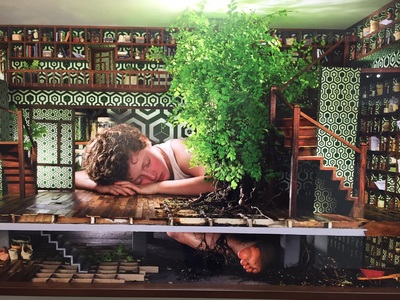
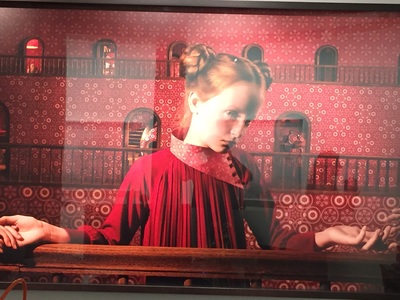
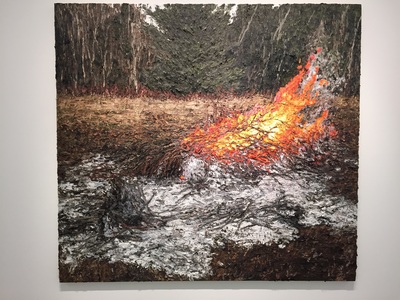
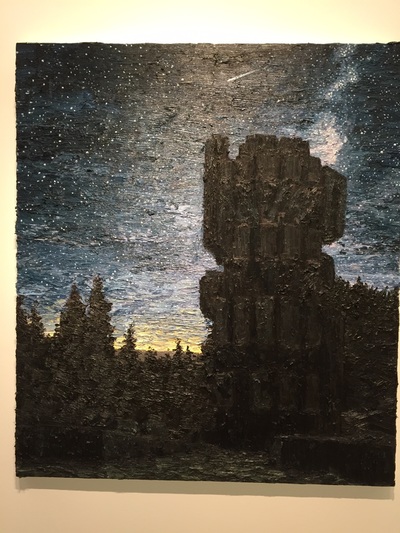
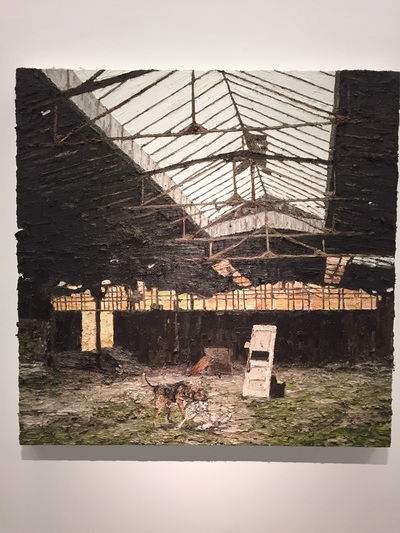
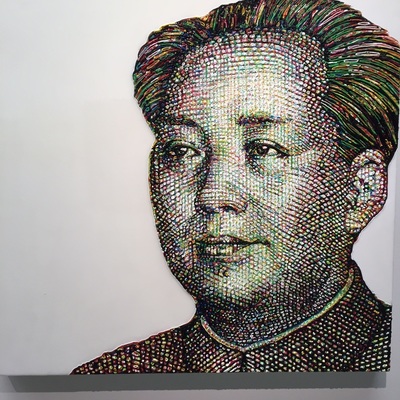
 RSS Feed
RSS Feed